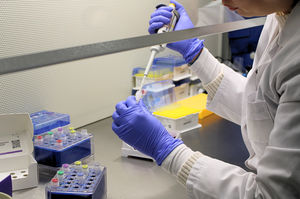
- Laboratory
- Laboratory medicine
- Solution reagent
- FIRALIS GROUP
- Company
- Products
- Catalogs
- News & Trends
- Exhibitions
Apolipoprotein E (ApoE) reagent kit APO-Easy® (CE-IVD)solutionfor DNA extractiondiagnostic

Add to favorites
Compare this product
Characteristics
- Type
- solution
- Applications
- diagnostic, for DNA extraction, NGS, for genotyping, for amplification reaction
- Tested parameter
- for apolipoproteins, Apolipoprotein E (ApoE), genetic, genomic DNA
- Origin
- human-based
- Other characteristics
- with sample tube, Alzheimer biomarkers
- Storage temperature
Min.: 2 °C
(36 °F)Max.: 8 °C
(46 °F)-20 °C
(-4 °F)
Description
The APOE gene on chromosome 19, responsible for coding apolipo-protein E, is genetically linked to both common late-onset familial and sporadic forms of AD. The human APOE gene comprises three alleles: -ε2, -ε3, and -ε4 distributed in the population at 7%, 79%, and 14%, respectively.
Having one or two copies of the ε4 allele in APOE gene is statistically associated with an increased risk of developing AD. Approximately 65% of AD patients in the Caucasian population carry the APOE ε4 allele.
ACCURACY RATE
Exhibiting outstanding analytical performance with perfect reproducibility and repeatability.
HOURS
to complete the entire process
REDUCTION IN MASTER MIX VOLUME
yet the reliability is maintained demonstrating its robustness
LIMIT OF DETECTION
ensuring sensitivity in detecting target genetic material.
Streamlined process
Extract
Genomic DNA (gDNA) extraction from whole human blood, saliva and buccal swab collected into PAXgene Blood DNA tubes and quantification.
Run
qPCR amplification and fluorogenic detection of APOE mutations using QS™ 5 Dx RT-PCR System and CFX Opus 96 Dx RT-PCR System
Analyze
Sample result analysis and interpretation.
qPCR genotyping
AD genotyping involves identifying genetic variations, using molecular biology techniques such as PCR, Sanger sequencing, and Next-Generation Sequencing (NGS). Method selection depends on study goals, scale, cost, and desired resolution.
Key assay parameters
OPERATING TIME
The procedure comprises two phases:
30 minutes for plate preparation and 1 hour and 29 minutes for the qPCR cycle.
ASSAY VALIDATION
Validated on the QuantStudio 5 Dx Real-Time PCR system
VIDEO
Catalogs
No catalogs are available for this product.
See all of FIRALIS GROUP‘s catalogs*Prices are pre-tax. They exclude delivery charges and customs duties and do not include additional charges for installation or activation options. Prices are indicative only and may vary by country, with changes to the cost of raw materials and exchange rates.


